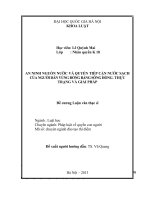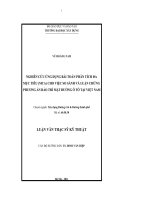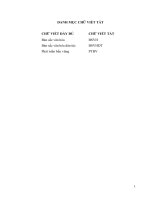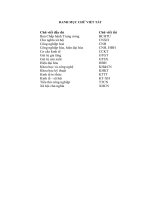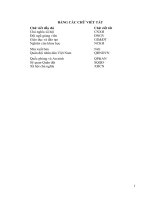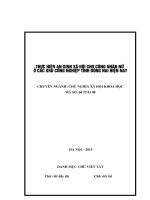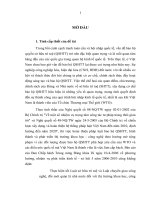(Luận văn thạc sĩ) an investigation into gender bias in vietnamese secondary school EFL textbook dialogues
Bạn đang xem bản rút gọn của tài liệu. Xem và tải ngay bản đầy đủ của tài liệu tại đây (1.09 MB, 58 trang )
VIETNAM NATIONAL UNIVERSITY, HANOI
UNIVERSITY OF LANGUAGES AND INTERNATIONAL STUDIES
FACULTY OF POST – GRADUATE STUDIES
*********************
NGUYỄN THỊ NGỌC HÀ
AN INVESTIGATION INTO GENDER BIAS
IN VIETNAMESE SECONDARY SCHOOL EFL TEXTBOOK DIALOGUES
(Nghiên cứu về sự thiên vị giới tính trong các đoạn hội thoại
thuộc sách giáo khoa tiếng Anh dành cho bậc THCS tại Việt Nam)
M.A MINOR THESIS (Type I)
Field: English Teaching Methodology
Code: 8140231.01
Hanoi – 2019
VIETNAM NATIONAL UNIVERSITY, HANOI
UNIVERSITY OF LANGUAGES AND INTERNATIONAL STUDIES
FACULTY OF POST – GRADUATE STUDIES
*********************
NGUYỄN THỊ NGỌC HÀ
AN INVESTIGATION INTO GENDER BIAS
IN VIETNAMESE SECONDARY SCHOOL EFL TEXTBOOK DIALOGUES
(Nghiên cứu về sự thiên vị giới tính trong các đoạn hội thoại
thuộc sách giáo khoa tiếng Anh dành cho bậc THCS tại Việt Nam)
M.A MINOR THESIS (Type I)
Field: English Teaching Methodology
Code: 8140231.01
Supervisor: Prof. Dr. Hoang Van Van
Hanoi – 2019
DECLARATION
I hereby declare that this thesis is my own work and effort and it has not been submitted
to any other university or institution wholly or partially.
Hanoi, May 2019
Nguyen Thi Ngoc Ha
i
ACKNOWLEDGEMENTS
My graduation thesis has been completed with the support of a great number of people.
First of all, I would like to express my deep gratitude to my supervisor Prof. Dr. Hoang
Van Van who gave me a lot of valuable guidance, encouragement, criticisms and
correction throughout my thesis writing.
Secondly, I would like to thank Dr. Huynh Anh Tuan, Head of Faculty of Post Graduate
Studies, and the rest of the council members for granting me the permission to conduct
this thesis.
Last but not least, My sincere thanks go to my family, my friends for their
encouragement and support that help me to complete my work.
ii
ABSTRACT
This investigation is a quantitative study of dialogues in eight EFL textbooks used in
lower secondary schools in Vietnam. The chosen textbooks are Tiếng Anh 6 tập 1, Tiếng
Anh 6 tập 2, Tiếng Anh 7 tập 1, Tiếng Anh 7 tập 2, Tiếng Anh 8 tập 1, Tiếng Anh 8 tập 2,
Tiếng Anh 9 tập 1, and Tiếng Anh tập 2. The aim is to investigate if there is any overrepresentation of female or male characters in the dialogues in the textbooks currently
being used in Vietnam. This study was conducted over the dialogues of each textbook,
and the researcher will look at four different typologies: (1) The number of times
male/female character initiated dialogue; (2) The number of turns taken; (3) The number
of characters; and (4) The number of words used. The findings show that gender overrepresentation occurs in all of the investigated textbooks. To be more specific, two of the
eight textbooks over-represented female characters while the other six textbooks overrepresented male ones. It is also worth mentioning that there is a shift from maledominated dialogues to more female-dominate dialogues from 2013 to 2016. Some
pedagogical implications have been suggested to textbooks writers and learners in terms
of gender bias in textbook dialogues.
Keywords: gender over-representation, textbook dialogues, pedagogical implications
iii
TABLE OF CONTENT
DECLARATION ............................................................................................................. i
CHAPTER I: INTRODUCTION ..................................................................................... 1
1.1 Rationale for the Study ............................................................................................ 1
1.2 Aim and Objectives of the Study............................................................................. 2
1.3 Research Questions .................................................................................................. 3
1.4. Scope of the Study ................................................................................................... 3
1.5 Significance of the Study .......................................................................................... 4
1.5.1. Theoretical Significance ................................................................................... 4
1.5.2. Practical Significance ........................................................................................ 4
1.6 Organization of the Thesis ....................................................................................... 4
CHAPTER II: LITERATURE REVIEW ....................................................................... 6
2.1. Review of Previous Studies Related to the Research Area of the Thesis ........... 6
2.1.1.
Studies of Gender Bias in EFL Textbooks in the World ........................... 6
2.1.2 Studies of Gender Bias in EFL Textbooks in Vietnam ................................... 9
2.2. Review of Theoretical Background ..................................................................... 10
2.2.1. Gender Theory ................................................................................................ 10
2.2.2 Influences of Gender Bias in Foreign Language Textbook Dialogues ........ 11
CHAPTER III: METHODOLOGY ............................................................................... 16
3.1 Research Type ......................................................................................................... 16
3.2 Research Setting ..................................................................................................... 16
3.3 Material Selection ................................................................................................... 17
3.4 Research Methodology ........................................................................................... 17
3.5. Analytical Framework of the Study .................................................................... 19
3.5. Data Collection Procedure .................................................................................... 19
iv
3.6. Data Analysis Procedures ..................................................................................... 21
CHAPTER IV: FINDINGS AND DISCUSSION ......................................................... 22
4.1 Tiếng Anh 6 tập 1 .................................................................................................... 22
4.2 Tiếng Anh 6 tập 2 .................................................................................................... 23
4.3 Tiếng Anh 7 tập 1 .................................................................................................... 25
4.4 Tiếng Anh 7 tập 2 .................................................................................................... 27
4.5 Tiếng Anh 8 tập 1 .................................................................................................... 29
4.6 Tiếng Anh 8 tập 2 .................................................................................................... 31
4.7 Tiếng Anh 9 tập 1 .................................................................................................... 32
4.8 Tiếng Anh 9 tập 2 .................................................................................................... 35
4.9. Analysis and Discussion of the Findings ............................................................. 37
4.10. Pedagogical Implications .................................................................................... 40
CHAPTER V: CONCLUSION....................................................................................... 42
5.1. Recapitulation ........................................................................................................ 42
5.2. Limitations of the Study........................................................................................ 43
5.3. Suggestions for Future Research ......................................................................... 44
REFERENCES ................................................................................................................. 45
GLOSSARY ..................................................................................................................... 49
v
LIST OF TABLES
Table 1. Summary of Tiếng Anh 6 tập 1 ........................................................................ 22
Table 2. Summary of Tiếng Anh 6 tập 2 ........................................................................ 23
Table 3. Summary of mixed-gender dialogues in Tiếng Anh 6 tập 2 .......................... 24
Table 4. Summary of Tiếng Anh 7 tập 1 ........................................................................ 25
Table 5. Summary of mixed-gender dialogues in Tiếng Anh 7 tập 1 .......................... 26
Table 6. Summary of same-gender dialogues in Tiếng Anh 7 tập 1 ............................ 26
Table 7. Summary of Tiếng Anh 7 tập 2 ........................................................................ 28
Table 8. Summary of mixed-gender dialogues in Tiếng Anh 7 tập 2 .......................... 28
Table 9. Summary of same-gender dialogues in Tiếng Anh 7 tập 2 ............................ 29
Table 10. Summary of Tiếng Anh 8 tập 1 ...................................................................... 30
Table 11. Summary of mixed-gender dialogues in Tiếng Anh 8 tập 1 ........................ 30
Table 12. Summary of Tiếng Anh 8 tập 2 ...................................................................... 31
Table 13. Summary of mixed-gender dialogues in Tiếng Anh 8 tập 2 ........................ 32
Table 14. Summary of Tiếng Anh 9 tập 1 ...................................................................... 33
Table 15. Summary of Tiếng Anh 9 tập 1 ...................................................................... 33
Table 16. Summary of same-gender dialogues in Tiếng Anh 9 tập 1 .......................... 34
Table 17. Summary of Tiếng Anh 9 tập 2 ...................................................................... 35
Table 18. Summary of mixed-gender dialogues in Tiếng Anh 9 tập 2 ........................ 36
Table 19. Summary of same-gender dialogues in Tiếng Anh 9 tập 2 .......................... 37
vi
LIST OF ABBREVIATION
EFL: English as a Foreign Language
ESL: English as a Second Language
UNESCO: United Nations Educational Scientific and Cultural Organizations
vii
CHAPTER I: INTRODUCTION
This chapter provides background information and rationale of the study. It is subdivided
into six sections, namely (a) rationale for the study, (b) aim and objectives of the study,
(c) research questions, (d) scope of the study, significance of the study and organization
of the thesis.
1.1 Rationale for the Study
As an English teacher, not only the chance but also the amount of time each student is
given to practice English in a lesson is what I pay attention to. However, there were times
the textbook dialogues did not support me. For example, one day, I invited two male
students and two female students to read a dialogue. While my expectation was to share
the chance to practice English among students, it turned out that the girls‟ turns were far
fewer than boys‟ and at the very end of the conversation. Another instance is that on the
day I taught the unit whose topic was “At the Science Club” (Tiếng Anh 8 tập 1), seeing
that some female students were not interested, I intended to get them to read the dialogue.
Unfortunately, in that dialogue, there was only one female character who discussed the
roles of science and technology with three men. That was also the day I started to wonder
whether the textbooks I was using treat men prior to women.
According to the Order of the President of the State on Promulgation of Law (June 2005),
schools or other educational institutions are responsible for giving the learners the
respect, equal treatment and provide them with the adequate information concerning their
own learning and training by schools or other educational institution. One of the
important missions of the school system is to teach students the value of equality and for
teachers to teach in a way that encourages equality. As a result, the school should actively
and consciously further equal rights and opportunities for men and women.
While the national curriculum highlights the importance of providing equal learning
opportunities for both boys and girls, this is not always the case in the classroom or in the
teaching
materials
being
used
in
the
1
classroom
(Mesthrie
et
al.,
2000;
Bayyurt & Litosseliti, 2006). It is a fact that research carried out during the past four
decades found that texts and dialogues in EFL textbooks presented an imbalance in
gender representation and traditional gender roles (Hartman & Judd, 1978; Jones et al.,
1995; Bayyurt & Litosseliti, 2006). On a positive note, some research revealed that a
balanced representation of female and male characters in texts and textbook dialogues has
improved over the years (Jones, Kitetu & Sunderland, 1995; Poulou, 1997). However, an
unbalanced representation of gender still exists in textbooks.
With regards to gender bias in textbooks, it has been discussed for a long time in the
world but in Vietnam up to the present, to the author‟s knowledge, the first and only
researcher who has investigated into gender bias in EFL textbooks is Nguyen Doan Canh
(2016). However, he focused on the linguistic sexism as well as the hidden message
conveyed via the occurrence of linguistic sexism. That means the phenomenon of gender
over-representation in EFL textbooks has never been studied and still a mystery.
The above-mentioned reasons have urged me to carry out the present research to find out
the status of gender over-representation in the current lower secondary EFL textbooks in
Vietnam and hopefully, the result of the study may be useful for English teachers and
makes a contribution to the field of textbook analysis and evaluation in Vietnam.
1.2 Aim and Objectives of the Study
The main aim of this study is to investigate the issue of gender bias in the current
Vietnamese lower secondary English language textbook dialogues: Tiếng Anh 6 tập 1,
Tiếng Anh 6 tập 2, Tiếng Anh 7 tập 1, Tiếng Anh 7 tập 2, Tiếng Anh 8 tập 1, Tiếng Anh 8
tập 2, Tiếng Anh 9 tập 1, Tiếng Anh 9 tập 2 written by Hoang Han Van et al. and
published by Ministry of Education and Training (MOET).
The main aim above is specified into specific objectives of the research as follows: (1) to
find out the unbalanced representation exists in the current Vietnamese low-secondary
EFL textbook dialogues: Tiếng Anh 6 tập 1, Tiếng Anh 6 tập 2, Tiếng Anh 7 tập 1, Tiếng
Anh 7 tập 2, Tiếng Anh 8 tập 1, Tiếng Anh 8 tập 2, Tiếng Anh 9 tập 1, Tiếng Anh 9 tập 2
2
in terms of number of characters, number of times female and male characters initiated
dialogue, number of turns taken by male and female characters as well as number of
words allocated female and male characters in these dialogues and (2) to suggest
pedagogical implications concerning gender bias in textbook dialogues to authors and
teachers in Vietnam.
1.3 Research Questions
The researcher will look at eight EFL textbooks currently being used at lower secondary
schools in Vietnam and investigate the following questions:
1. To what extent EFL Vietnamese lower secondary school EFL textbook dialogues:
Tiếng Anh 6 tập 1, Tiếng Anh 6 tập 2, Tiếng Anh 7 tập 1, Tiếng Anh 7 tập 2, Tiếng
Anh 8 tập 1, Tiếng Anh 8 tập 2, Tiếng Anh 9 tập 1, Tiếng Anh 9 tập 2
over-
represent a particular gender?
2. What pedagogical implications should be suggested to textbook authors and
teachers in terms of gender bias in textbook dialogues?
1.4. Scope of the Study
Gender bias can be found in various materials, especially in teaching and learning
materials such as textbooks. In Vietnamese EFL textbooks, to the author‟s knowledge,
there has never been any study of gender bias in dialogues before. However, this study
does not mention gender bias in all of the Vietnamese EFL textbook dialogues. Besides,
the study can hardly cover a comprehensive analysis of gender bias in these EFL
textbook dialogues because gender bias in textbook dialogues may be portrayed in other
aspects such as sexist stereotypes. Therefore, this thesis only focuses on gender overrepresentation (initiations, turns, characters and words) in dialogues used in eight current
lower secondary EFL textbooks: Tiếng Anh 6 tập 1, Tiếng Anh 6 tập 2, Tiếng Anh 7 tập 1,
Tiếng Anh 7 tập 2, Tiếng Anh 8 tập 1, Tiếng Anh 8 tập 2, Tiếng Anh 9 tập 1, Tiếng Anh 9
tập 2 by Hoang Van Van et al.
3
1.5 Significance of the Study
1.5.1. Theoretical Significance
This research focuses on gender over-representation in specific English teaching
materials with the hope of contributing to existing knowledge on gender bias in EFL
textbooks. In Vietnam, from the first research on linguistic sexism in current upper
secondary Vietnamese English textbooks carried out by Nguyen Doan Canh (2016), there
is no Vietnamese researchers who have investigated into the gender over-representation
in EFL textbooks. The study would be a vivid illustration of gender over-representation
in Vietnamese EFL textbook dialogues.
1.5.2. Practical Significance
Hopefully, this study may urge Vietnamese educators and textbook designers take gender
over-representation into serious consideration. Certainly, a balanced representation of
genders is one of the factors contributing to the equal learning opportunities in English
classes. The findings of the study could also be beneficial in the school environment
because it will help raise awareness of teachers on the issue of gender bias in textbooks.
They will be prepared to adjust their application of these textbook dialogues to ensure the
proportion of man and woman participating in the study and training which is a measure
to promote gender equality in the file of education and training according to Act 14, The
Law on Gender Equality (The National Assembly, 2006)
1.6 Organization of the Thesis
The results are presented into a thesis and overall conclude six chapters.
Chapter I: Introduction: deals with the rationale, aims and objectives, research
questions, scope, significance and organization of the study.
Chapter II: Literature Review: provides the previous research and theories on several
aspects of gender imbalance in English teaching materials.
4
Chapter III: Methodology: describes the research type, research setting, material
selection, research methodology, analytical framework of the study and process of
conducting the research.
Chapter IV: Findings and Discussion: presents the results of the research, discusses the
major findings, and then provides some pedagogical implications drawn from the
research.
Chapter V: Conclusion: provide an overview of the investigation, point out limitations,
and make some suggestions for further research
5
CHAPTER II: LITERATURE REVIEW
This chapter will take an in-depth look at the previous studies on gender bias in EFL
textbooks in the world as well as in Vietnam. It will also provide the theoretical
background of the research issue.
2.1. Review of Previous Studies Related to the Research Area of the Thesis
The issue of gender bias in foreign language textbooks has been of a great deal of interest
to researchers in the world for several decades but not many researchers in Vietnam have
investigated the phenomenon. In this section, a review of previous studies related to
gender bias in foreign language textbooks both in the world and in Vietnam will be
discussed.
2.1.1. Studies of Gender Bias in EFL Textbooks in the World
In the 1970s the feminist movement and women‟s studies provided a framework for
research in Language and Gender Studies. Since then, studies and critiques in this area
have proliferated. It is a fact that studies carried out in the 1970s, 1980s, 1990s and 2000s
have found that gender bias has often manifested itself with over-representation of male
characters in textbook texts.
In the late 1970s, Pat Hartman and Elliot Judd (1978) conducted an investigation into
gender bias in Teachers of English to Speakers of Other Languages (TESOL) textbooks.
In this study, fifteen TESOL textbooks which had been published in the late 1960s and
early 1970s and were being used in the United States and Britain were selected for
examination. The study pointed out that in these textbooks “women are often less visible
than men, are often the butt of many jokes and are often placed in 13 stereotypical roles
and assigned stereotypical emotional reactions” (Hartman & Judd, 1978, p. 383). It is
interesting to note that in 1975 the American organization National Council of Teachers
of English adopted a formal policy to encourage non-sexist language usage by publishers.
Nevertheless, in spite of these efforts, gender bias was undeniable.
6
In the next decade, six years after Hartman and Judd‟s study, Karen Porreca (1984)
conducted a similar study of English as a Second Language (ESL) textbooks. Porreca
selected fifteen ESL textbooks purchased in the largest quantities by twenty-seven ESL
locations in the USA. Porreca reinvestigated gender bias in EFL textbooks by analyzing
texts and illustrations in a quantitative manner. Her results supported the findings of
Hartman and Judd and she warned that there may be consequences with unrealistic
depictions of females and males. She detected a large presence of the masculine generic
construction where the textbook characters first appeared to be neutral characters but
were invariably male characters rather than neutral or female characters. According to
Sadker and Zittleman (2007), some publishers and authors of textbooks try to create “an
illusion of equality” (p. 273) and thus might include pictures of women instead of
revising the texts. While a neutral character might create a sense of unbiased gender
representation, a masculine generic construction might perpetuate asymmetric gender
representation.
One textbook in Porreca‟s (1984) research, English Sentence Structure, used a repetitive
pattern drill which most often featured a male character „John‟. Porreca mentioned that
“this type of all-male exercise (with five or more sentences) occurs 54 times throughout
the book. The number of instances of similar all-female exercises is 6” (p. 714). Porreca‟s
study did not discuss if the drill prevented girls from being „John‟ or the other males in
the exercise but the message is clear that „John‟ and the other males dominated this type
of exercise and therefore may have conveyed the general impression that females rate
lower than males. Freeman and McElhinny (1996) stated that “[e]ducational settings also
give students an understanding of their social identity in relation to each other and the
institution” (as quoted in Bayyurt & Litosseliti, 2006, p. 73). A male-ominated text might
suggest that boys have a right to be verbally dominant in the classroom and further that
girls should say less in the classroom compared to boys. Porreca (1984) warned that
textbooks represent authority and that a gender-biased text could have consequences for
7
ESL learners, in particular, “younger ESL learners, whose limited experience gives them
little basis for questioning what they read” (p. 723).
Jane Sunderland (1998) looked at gender bias in textbook texts and classroom
interactions and supported the argument that gender bias existed in textbooks and in the
classroom. This was based on both on her own observations and previous research done
in the 1970s and 1980s. While Sunderland recognized that gender bias existed, she
questioned whether it was actually important or not. Sunderland felt it was important to
those who were concerned with gender bias, but felt it was not important to some
teachers unless that gender-biased texts affected learning. Stating we can never predict
how a reader might respond to a text, she pointed out the impossibility of providing a
correlation between biased texts and learning.
Sunderland (1998) further pointed out that gender-biased text affect readers in many
ways: Some students may accept the bias and even enjoy it, […]; others may recognize it
for what it is and become „resistant readers‟, rejecting either the gender representation
itself or the gendered assumptions within the text (p.4).
Sunderland (1998) also observed that teachers played an important role in the discussion
of gender bias. She noted that a text which seemed unbiased could have been interpreted
or handled in an unbiased way.
Some recent studies carried out in the last decade show that the situation is slowly
improving even if it is still far from being ideal. With regard to some EFL textbooks
published in the late 1990s, Sano, Iida and Hardy (2001) state that they “contain genderbased implicit messages, even though no explicit linguistic features are articulated on the
surface level” (p. 905). Otlowsky‟s (2003) findings show that women in EFL textbooks
are still represented as housekeepers and mothers. Concerning textbooks of French as a
foreign language, Lee and Collins‟ (2006) focus on how changes in the status of women
are reflected in Hong Kong English-language textbooks. Their conclusions stated that
compared with the past, many modern textbooks use various strategies to avoid biased or
stereotypical treatment of the two sexes. However, women are still commonly associated
8
with housework and the home, and men with paid work outside. Women are weak and
passive, while men are strong and active. Finally, men are still more visible than women.
Mineshima (2008), studied gender representations in an EFL textbook to investigate how
it portrays the two genders. She examined sexism in three categories including the
number of females versus males, the number of their utterances and firstness. The results
of the research revealed that females were under-presented and overloaded with
traditional stereotype roles whereas males appeared only as cooperative and optional.
Most recently, Sulaimani (2017) carried out an investigation into gender frequencies in
conversations in three dimensions: gender relations, subject positions and contents in an
EFL textbook that has been specifically adapted for the Saudi Arabian context. The
results indicated that women in this textbook are under-represented and have been totally
excluded from half of the units in the textbook. Also, the equal relations between the two
genders are limited to friendship.
From the above-mentioned studies, it is easy to realize the attraction of gender bias in
textbooks to the world researchers for nearly half a century from Europe through
America to Asia. In many teaching and learning materials examined, it was found that
females are less visible than males and that there is gender bias against women. The
question I have raised for myself is whether or not the issue of gender over-representation
in Vietnamese EFL textbooks. If so, is it the same or different in comparison with the
problem in the textbooks studied before?
2.1.2 Studies of Gender Bias in EFL Textbooks in Vietnam
The first researcher who has systematically studied gender bias in EFL textbooks is
Nguyen Doan Canh (2016). In his works entitled Linguistic Sexism in current upper
secondary school English language textbooks: Tiếng Anh 10, Tiếng Anh 11 and Tiếng
Anh 12, evidence that linguistic sexism at word and phrase levels exists was found. This
phenomenon occurs rather often in all of the three categories investigated: morphology,
semantics and syntax. Moreover, it is remarkable that hidden messages conveyed via
linguistic sexism at word and phrase levels in the books are much more against women
9
than men. It can be understood through the linguistic sexism in the books that women
seem to be excluded from human beings, secondary and dependent while men appear to
include all people, superior and independent.
After Nguyen Doan Canh‟s study, there is still a shortage of investigation into gender
over-representation in Vietnamese EFL textbooks. This has partly urged me to perform
the research.
2.2. Review of Theoretical Background
2.2.1. Gender Theory
In this research, the gender concept was used to analyze Vietnamese EFL textbooks.
Gender comes from the British word which means „sex‟. However, Saptari (1997:89)
argues that gender is not limited to sex or biological differences, it is more related to the
differentiation of symbol and social status because of sex (as quoted in Darmi & Abida,
2017). It is crucial to recognize the distinction between sex and gender. Sex refers to the
biological differences between male and female while gender is a system of social
stratification and differentiation on the basis of sex. Sexologist John Money drew the
terminological distinction between biological sex and gender as a role in 1955. Before his
work, it was uncommon to use the word gender to refer to anything but grammatical
categories (Lindsey, 2010). However, Money's meaning of the word did not become
widespread until the 1970s, when feminist theory embraced the concept of a distinction
between the social construct of gender and biological sex.
According to UNESCO (2009), “gender” refers to the roles and responsibilities of men
and women that are created in our families, our societies and our cultures. The concept of
gender also includes the expectations held about the characteristics, aptitudes and likely
behaviors of both men and women. Gender is socially constructed: gender roles and
expectations are learned, can change over time, and vary within and between cultures.
For example, most cultures use a gender binary, having two genders (boys/men and
10
girls/women); those who exist outside these groups fall under the umbrella term nonbinary while some societies have specific genders besides "man" and "woman".
From these definitions, it can be inferred that “gender” refers to a wide set of
characteristics that are seen to distinguish between male and female entities, extending
from one‟s biological sex to one‟s social role.
2.2.2 Influences of Gender Bias in Foreign Language Textbook Dialogues
At present, the use of textbook is a key resource among language educators. However,
pedagogues can never predict how students will interpret a text. Regardless of what the
author has in mind, interpretations might be individual and subjective (Jones, Kitetu &
Sunderland, 1997, pp. 1-2). Jones, Kitetu and Sunderland (1997) indicated that learners
may unconsciously absorb what can be considered as gender stereotypes through media
and society as well as textbooks in school. Further, they pointed out a tendency in older
textbooks to portrait women as homemakers and men as businessmen. They bring to
surface the concern that this may adversely affect women‟s learning as well as
conception in how they view themselves.
“The images and language which are used in teaching and the extent to which
learners can identify with them have an important effect on how well people learn.
If women are under-represented in teaching or represented in demeaning way, the
women who are taught with these materials may learn less well.” (Jones, Kitetu &
Sunderland, 1997, p.2)
Jones, Kitetu and Sunderland (1995) stated that “dialogues are of considerable potential
value in providing different types of language learning opportunities” (p.4). Jones, Kitetu
and Sunderland further stated that dialogues served several purposes. Dialogues provided
a model of the target language in terms of language form and social context in which the
target language should be used. While some might question whether practice makes
perfect, it is the authors‟ general belief that practice provides valuable opportunity to train
11
pronunciation and other pragmatic aspects of speaking the target language as well as
provides social context in how the language is to be used in conversations.
Jones, Kitetu and Sunderland (1997, pp.1-4) believe that textbook dialogues are often
used in various teaching situations. Dialogues can consist of taped or written
conversation between two people, and can be used in three various ways when it comes
to learning languages.
Firstly, as role-play the dialogues help to develop knowledge of the language by
contributing to the broadening of students‟ vocabulary, their ability to use
expressive and figurative speech and syntactic competence.
Secondly, dialogues tend to also provide social knowledge through the context as
well as practice of a new language.
It also facilitates practice which develops fluency.
From a pedagogical point of view, dialogues are valuable opportunities to prove language
practice and proficiency. There can be listed a number of advantages of using dialogue in
teaching, even the quietest students tend to participate, instead of only the most
successful speakers in class. However, dialogues that lack gender balance can be turned
into an obstacle that hinders girls‟ language learning. (Jones. Kitetu & Sunderland (1997,
pp. 4-9).
Jones, Kitetu and Sunderland (1995) have analyzed three EFL textbooks which were
published between 1987 and 1994. They found that there was some gender bias in the
textbook dialogues but on the whole, the bias was not extreme. In the textbook published
in 1987, female characters rated higher in words used (302 versus 248) and initiated
conversations more often than male characters (5 versus 4). Male characters, however,
had an average of 27.5 words spoken per male characters whereas female characters
averaged 23.2 words per female character. While the female characters were overrepresented in two of these typologies, the differences were not great. In the 1993
textbook, the findings were similar and did not show any significant gender bias. In the
12
textbook published in 1994, female characters once more used more words (632 versus
501) and initiated more conversations (6 versus 3). Male characters, however, averaged
50.1 words spoken per male character compared to an average of 31.6 words spoken by
female characters.
Jones, Kitetu and Sunderland examined two types of English as Second Language (ESL)
textbooks and concluded that, in mix-gender dialogues, women were described as the
ones asking for information and men as the ones providing it. Further, they stated that, on
average, men initiated conversations and uttered more words than women. In comparison,
female characters spoke 2142 words and male characters 2482. As a result, Jones, Kitetu
and Sunderland (1999, pp. 4-15) pointed out that female learners‟ learning would be
limited and inhibited, for the reason that dialogues were often offered to be played by the
same gender, leading up to a situation where female characters were restricted
linguistically as well as occupationally. Due to those circumstances, the author issued the
importance of teachers asking themselves the questions; how does this affect my
classroom? What pedagogical implications are there for female and male learners? The
conclusion made by the authors was that a possible gender imbalance may affect
behavior in the classroom (Jones, Kitetu and Sunderland, 1999, pp. 4-15)
As Sunderland suggested (1998), it is impossible to predict how a biased text will affect
learning. She did, however, address the issue of how a biased textbook might provide an
unequal amount of speaking exercises for female and male characters. Sunderland (2000)
referred to a textbook from 1977, Function of English, which featured a dialogue
designed to practice initiating a conversation. While the purpose of the exercise was to
initiate a conversation, it was only a male character who initiated the conversations. Even
though this textbook is outdated, it is an example of how dialogues might exclude
speaking practice opportunities for girls and boys depending on how the dialogues are
designed and whether girls and boys are willing to “cross” gender and practice both
dialogues for female and male characters. In this particular example, if students were
13
unwilling to take on the other gender‟s role in the speaking exercise, it would imply that
boys would have the advantage of practicing initiating conversations.
Another important field study by Jones, Kitetu and Sunderland (1997) is the examination
of how textbook dialogues tend to not only function as language learning practice, they
also convey a social pattern by categorizing people, distributing occupational and social
roles. The authors presented how women and men are described in various dialogues.
They concluded that women mostly appeared in roles of a sister, a girlfriend, a mother
and a worker, etc. whereas men appeared as brothers, policemen, officers, etc. This
research showed that occupational roles in textbooks often portray contemporary or oldfashioned values in society. It can be summarized as a conclusion that a textbook simply
is a representation of society in general (Jones, Kitetu & Sunderland, 1997, pp.15-22)
Sofia Poulou (1997) conducted a quantitative study of sexism in two Greek foreign
language textbooks for adults. She looked at the number of utterances and words used by
female characters and male characters. In one of the textbooks, the male characters were
allocated 914 utterances and words in the dialogues compared to 801 allocated to female
characters. In other words, the male characters accounted for 53% of the utterances and
words in the dialogues, and female characters accounted for 47%. In the second textbook,
the male character was allocated 49% of the utterances and words in the dialogues
whereas the female character was allocated 51%. The study also looked at the initiation
and closing of dialogues by female and male characters and the types of words used. The
first textbook showed that male characters initiated 63% of the dialogues compared to
37% for the female characters. Male characters finished 65% of the dialogues compared
to 35% for the female characters. There was little difference between female and male
characters in the second textbook. The third investigation was qualitative and looked at
the types of words used and how they were used. Poulou (1997) noted that female
characters often made requests or asked for information while male characters often
provided directives or information. In a classroom situation, where a teacher might be
likely to ask boys to read male parts and girls to read female parts, it may be that boys
14
rarely practice the language function of making requests and girls rarely practice the
function of providing information. Poulou (1997) warned that if both boys and girls “do
not perform the same language functions in similar context […] students will possibly be
familiar only with those functions and styles they come across while reading” (p.72).
Poulou (1997) concluded her study stating: “It is surely worth making an attempt to
ensure a decent representation of the two sexes and not to allow language learners to be
disadvantaged by discrepancies in the verbal behavior between female and male textbook
characters” (p.72).
If textbook dialogues have more male characters or more words allocated to male
characters, does this mean that boys will have more practice opportunities? Sunderland
(2000) found that girls could take on male character speaking exercises, but boys were
unwilling to take on girl character speaking exercises. Sunderland observed that a
teacher, during a German lesson, asked two male volunteers to read a dialogue featuring
one male character and one female character. When no boys volunteered, two girls
volunteered and read the male character parts. In an interview with the boys after the
lesson, it became evident that the boys were not comfortable reading female character
parts. Sunderland (2000) noted that “girls can „cross‟ gender boundaries with impunity,
whereas boys cannot… it is most definitely not OK for them to „become‟ girls, even
temporarily, strategically and jokily.” (p.168). This would imply that girls had an
advantage over boys in terms of practicing speaking via prescribed speaking exercises as
they appeared to be more willing to take on both gender roles during a speaking exercise.
The research on textbook dialogues suggests that if there is gender bias, this may exclude
some learners. It is important to recognize that while a dialogue may over-represent one
gender in a quantitative analysis, another gender may be over-represented when the
results are analyzed qualitatively.
15
CHAPTER III: METHODOLOGY
This chapter will describe how the present study was conducted. This discussion covers
research type, research setting, material selection, research methodology, the analytical
framework of the study, data collection and analysis procedures.
3.1 Research Type
This research is a quantitative research on gender over-representation in the current lower
secondary English language textbooks in Vietnam.
3.2 Research Setting
Vietnamese general education system comprises three levels with 12 forms from 1 to 12:
primary level (Form 1-5 for children aged 6-11), lower secondary level (Form 6-9 for
children aged 11-15), and upper secondary level (Form 10-12 for children aged 15-17).
English is now a compulsory subject for all levels (from Grade 3 to Grade 12). As a
compulsory course at the lower secondary level, English is taught with three to five
periods (45 minutes long) of practice per week.
Tiếng Anh 6 tập 1, Tiếng Anh 6 tập 2, Tiếng Anh 7 tập 1, Tiếng Anh 7 tập 2, Tiếng Anh 8
tập 1, Tiếng Anh 8 tập 2, Tiếng Anh 9 tập 1 and Tiếng Anh 9 tập 2 that have been being
used at Vietnamese schools now were officially introduced by Vietnamese Ministry of
Education and Training in 2013, 2014, 2015 and 2016. Each textbook consists of 6 units
and 2 reviews, and each unit comprises 8 parts: Getting Started, A Closer Look 1, A
Closer Look 2, Communication, Skills 1, Skills 2, Looking Back and Project. In each
part, there are 3 phases: pre-task, while task and post-task with smaller tasks, activities
and exercises. These textbooks were written by a group of Vietnamese ELT specialists
headed by Hoang Van Van in collaboration with ELT specialists from Pearson Education
Publishing Group under the National Foreign Language 2020 Project. The goal of this
textbook series is “developing students‟ communicative competences through
communicative activities which provide opportunities to practice skills in meaningful
contexts and which encourage students to take increasing responsibility for their own
16



